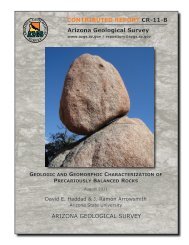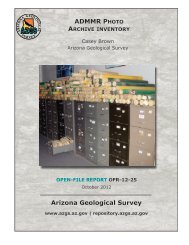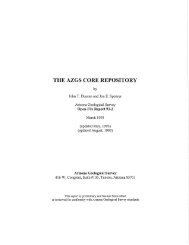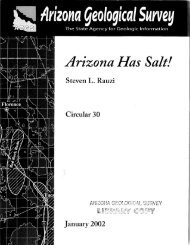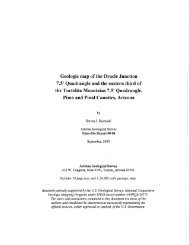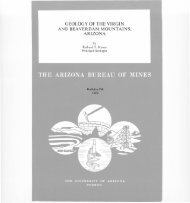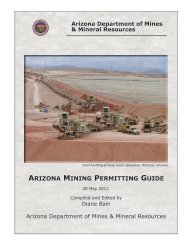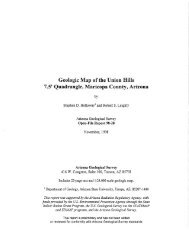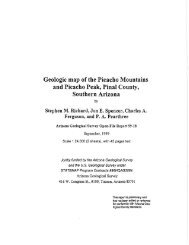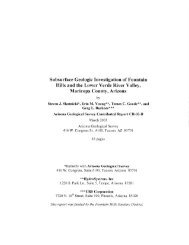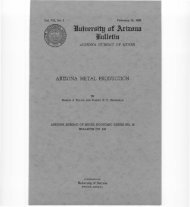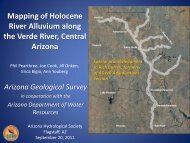Structural-Geologic Map Relationships in the Salcito Ranch Area,
Structural-Geologic Map Relationships in the Salcito Ranch Area,
Structural-Geologic Map Relationships in the Salcito Ranch Area,
Create successful ePaper yourself
Turn your PDF publications into a flip-book with our unique Google optimized e-Paper software.
(Drewes, 1974, 1977). The Mart<strong>in</strong>ez <strong>Ranch</strong> fault demarcates <strong>the</strong> eastern marg<strong>in</strong> of <strong>the</strong><br />
R<strong>in</strong>con Mounta<strong>in</strong>s, strik<strong>in</strong>g N-S and dipp<strong>in</strong>g 70ºE.<br />
Dick<strong>in</strong>son (1998) mapped <strong>the</strong> full extent of <strong>the</strong> Mart<strong>in</strong>ez <strong>Ranch</strong> fault at <strong>the</strong><br />
1:24,000 scale along a 30 km stretch from <strong>the</strong> I-10 freeway to <strong>the</strong> eastern edge of Mica<br />
Mounta<strong>in</strong>. The Mart<strong>in</strong>ez <strong>Ranch</strong> fault strikes essentially north-south, and dips eastward.<br />
In <strong>the</strong> study area, where <strong>the</strong> Mart<strong>in</strong>ez <strong>Ranch</strong> fault cuts and displaces <strong>the</strong> Catal<strong>in</strong>a<br />
detachment fault, it dips 55º east. At a much higher structural level, Dick<strong>in</strong>son (1998)<br />
notes that it dips more steeply, at ~70º east. The locale where this is observed is along<br />
Interstate10, where Neogene gravels are down faulted aga<strong>in</strong>st Lower Cretaceous<br />
Bisbee Group rocks. Offset along <strong>the</strong> Mart<strong>in</strong>ez <strong>Ranch</strong> fault <strong>in</strong> <strong>the</strong> study area is<br />
estimated to be ~ 2 km (Dick<strong>in</strong>son, 1998). Separat<strong>in</strong>g <strong>the</strong> R<strong>in</strong>con Mounta<strong>in</strong>s and <strong>the</strong><br />
Little R<strong>in</strong>con Mounta<strong>in</strong>s is a half graben of bas<strong>in</strong> fill, bordered on <strong>the</strong> west by <strong>the</strong><br />
Mart<strong>in</strong>ez <strong>Ranch</strong> fault (Dick<strong>in</strong>son, 1998)<br />
The map trace can be tightly p<strong>in</strong>ned <strong>in</strong> <strong>the</strong> sou<strong>the</strong>astern corner of our map area<br />
(see Plate 1), where upper plate sandstones and limestones (transformed to quartzite<br />
and marble) are <strong>in</strong> sharp contact with cataclasite or mylonite to <strong>the</strong> west. Both <strong>the</strong><br />
quartzite and marble strike parallel to <strong>the</strong> trace of <strong>the</strong> Mart<strong>in</strong>ez <strong>Ranch</strong> fault, and dip very<br />
steeply eastward. The resistant nature of <strong>the</strong> quartzite calls attention to <strong>the</strong> location of<br />
<strong>the</strong> fault, for <strong>the</strong> quartzite forms a tall strike wall, locally highly brecciated, right along <strong>the</strong><br />
contact.<br />
Our mapp<strong>in</strong>g reveals that mylonitic foliation and several structural geologic<br />
contacts are broadly dragged <strong>in</strong>to <strong>the</strong> Mart<strong>in</strong>ez <strong>Ranch</strong> fault (Plate 1, Figure 2). Note<br />
<strong>the</strong> change <strong>in</strong> dip of <strong>the</strong> subdetactment from its characteristic southwest trend to<br />
16



